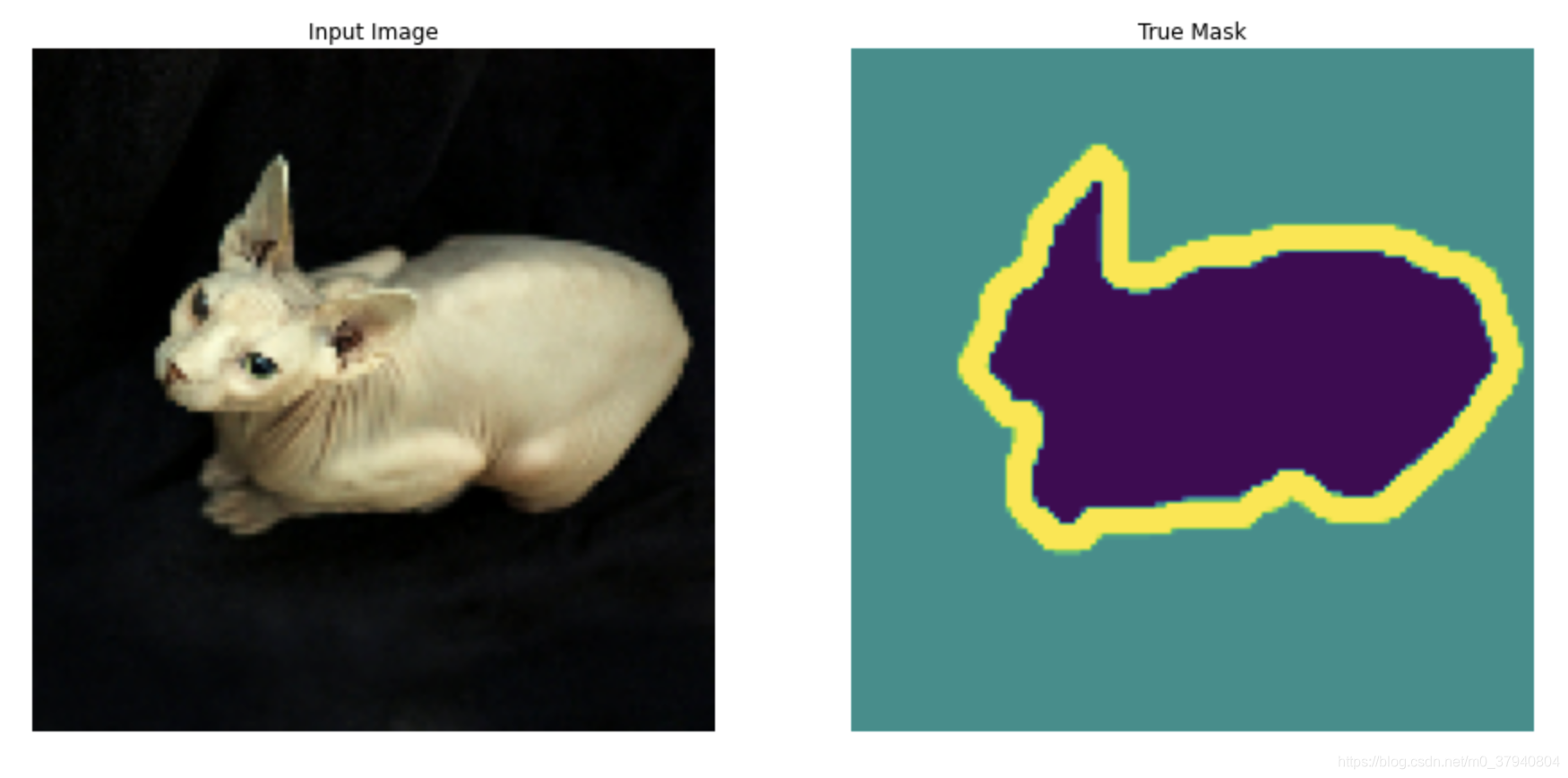
大家好,我是羽峰,今天要给大家分享的是一个图像分割网络,文章会把整个代码进行分割讲解,完整看完,相信你一定会有所收获。
目录
1. 认识图像分割
图像分割是指根据灰度、彩色、空间纹理、几何形状等特征把图像划分成若干个互不相交的区域,使得这些特征在同一区域内表现出一致性或相似性,而在不同区域间表现出明显的不同。简单的说就是在一副图像中,把目标从背景中分离出来。对于灰度图像来说,区域内部的像素一般具有灰度相似性,而在区域的边界上一般具有灰度不连续性。
传统方法有:
1. 基于阈值的分割方法
2. 基于区域的图像分割方法
3. 基于边缘检测的分割方法
4. 基于小波小波变换的图像分割方法
5. 基于遗传算法的图像分割
6. 基于主动轮廓模型的分割方法
2. 基于深度学习的分割
1. Oxford-IIIT Pet 数据集介绍
本教程将使用的数据集是 Oxford-IIIT Pet 数据集,由 Parkhi et al. 创建。该数据集由图像、图像所对应的标签、以及对像素逐一标记的掩码组成。掩码其实就是给每个像素的标签。每个像素分别属于以下三个类别中的一个:
- 类别 1:像素是宠物的一部分。
- 类别 2:像素是宠物的轮廓。
- 类别 3:以上都不是/外围像素。
pip install -q git+https://github.com/tensorflow/examples.gitimport tensorflow as tf
from tensorflow_examples.models.pix2pix import pix2pix
import tensorflow_datasets as tfds
tfds.disable_progress_bar()
from IPython.display import clear_output
import matplotlib.pyplot as plt
2. 下载 Oxford-IIIT Pets 数据集
这个数据集已经集成在 Tensorflow datasets 中,只需下载即可。图像分割掩码在版本 3.0.0 中才被加入,因此我们特别选用这个版本。
dataset, info = tfds.load('oxford_iiit_pet:3.*.*', with_info=True)
下面的代码进行了一个简单的图像翻转扩充。然后,将图像标准化到 [0,1]。最后,如上文提到的,像素点在图像分割掩码中被标记为 {1, 2, 3} 中的一个。为了方便起见,我们将分割掩码都减 1,得到了以下的标签:{0, 1, 2}。
def normalize(input_image, input_mask):
input_image = tf.cast(input_image, tf.float32) / 255.0
input_mask -= 1
return input_image, input_mask
@tf.function
def load_image_train(datapoint):
input_image = tf.image.resize(datapoint['image'], (128, 128))
input_mask = tf.image.resize(datapoint['segmentation_mask'], (128, 128))
if tf.random.uniform(()) > 0.5:
input_image = tf.image.flip_left_right(input_image)
input_mask = tf.image.flip_left_right(input_mask)
input_image, input_mask = normalize(input_image, input_mask)
return input_image, input_mask
def load_image_test(datapoint):
input_image = tf.image.resize(datapoint['image'], (128, 128))
input_mask = tf.image.resize(datapoint['segmentation_mask'], (128, 128))
input_image, input_mask = normalize(input_image, input_mask)
return input_image, input_mask数据集已经包含了所需的测试集和训练集划分,所以我们也延续使用相同的划分。
TRAIN_LENGTH = info.splits['train'].num_examples
BATCH_SIZE = 64
BUFFER_SIZE = 1000
STEPS_PER_EPOCH = TRAIN_LENGTH // BATCH_SIZE
train = dataset['train'].map(load_image_train, num_parallel_calls=tf.data.experimental.AUTOTUNE)
test = dataset['test'].map(load_image_test)
train_dataset = train.cache().shuffle(BUFFER_SIZE).batch(BATCH_SIZE).repeat()
train_dataset = train_dataset.prefetch(buffer_size=tf.data.experimental.AUTOTUNE)
test_dataset = test.batch(BATCH_SIZE)我们来看一下数据集中的一例图像以及它所对应的掩码。
def display(display_list):
plt.figure(figsize=(15, 15))
title = ['Input Image', 'True Mask', 'Predicted Mask']
for i in range(len(display_list)):
plt.subplot(1, len(display_list), i+1)
plt.title(title[i])
plt.imshow(tf.keras.preprocessing.image.array_to_img(display_list[i]))
plt.axis('off')
plt.show()
for image, mask in train.take(1):
sample_image, sample_mask = image, mask
display([sample_image, sample_mask])
3. 定义模型
这里用到的模型是一个改版的 U-Net。U-Net 由一个编码器(下采样器(downsampler))和一个解码器(上采样器(upsampler))组成。为了学习到鲁棒的特征,同时减少可训练参数的数量,这里可以使用一个预训练模型作为编码器。因此,这项任务中的编码器将使用一个预训练的 MobileNetV2 模型,它的中间输出值将被使用。解码器将使用在 TensorFlow Examples 中的 Pix2pix tutorial 里实施过的升频取样模块。
输出信道数量为 3 是因为每个像素有三种可能的标签。把这想象成一个多类别分类,每个像素都将被分到三个类别当中。
OUTPUT_CHANNELS = 3如之前提到的,编码器是一个预训练的 MobileNetV2 模型,它在 tf.keras.applications 中已被准备好并可以直接使用。编码器中包含模型中间层的一些特定输出。注意编码器在模型的训练过程中是不会被训练的。
base_model = tf.keras.applications.MobileNetV2(input_shape=[128, 128, 3], include_top=False)
# 使用这些层的激活设置
layer_names = [
'block_1_expand_relu', # 64x64
'block_3_expand_relu', # 32x32
'block_6_expand_relu', # 16x16
'block_13_expand_relu', # 8x8
'block_16_project', # 4x4
]
layers = [base_model.get_layer(name).output for name in layer_names]
# 创建特征提取模型
down_stack = tf.keras.Model(inputs=base_model.input, outputs=layers)
down_stack.trainable = FalseDownloading data from https://storage.googleapis.com/tensorflow/kerasapplications/mobilenet_v2/mobilenet_v2_weights_tf_dim_ordering_tf_kernels_1.0_128_no_top.h5 9412608/9406464 [==============================] - 0s 0us/step
解码器/升频取样器是简单的一系列升频取样模块,在 TensorFlow examples 中曾被实施过。
up_stack = [
pix2pix.upsample(512, 3), # 4x4 -> 8x8
pix2pix.upsample(256, 3), # 8x8 -> 16x16
pix2pix.upsample(128, 3), # 16x16 -> 32x32
pix2pix.upsample(64, 3), # 32x32 -> 64x64
]def unet_model(output_channels):
inputs = tf.keras.layers.Input(shape=[128, 128, 3])
x = inputs
# 在模型中降频取样
skips = down_stack(x)
x = skips[-1]
skips = reversed(skips[:-1])
# 升频取样然后建立跳跃连接
for up, skip in zip(up_stack, skips):
x = up(x)
concat = tf.keras.layers.Concatenate()
x = concat([x, skip])
# 这是模型的最后一层
last = tf.keras.layers.Conv2DTranspose(
output_channels, 3, strides=2,
padding='same') #64x64 -> 128x128
x = last(x)
return tf.keras.Model(inputs=inputs, outputs=x)4. 训练模型
现在,要做的只剩下编译和训练模型了。这里用到的损失函数是 losses.sparse_categorical_crossentropy。使用这个损失函数是因为神经网络试图给每一个像素分配一个标签,和多类别预测是一样的。在正确的分割掩码中,每个像素点的值是 {0,1,2} 中的一个。同时神经网络也输出三个信道。本质上,每个信道都在尝试学习预测一个类别,而 losses.sparse_categorical_crossentropy 正是这一情形下推荐使用的损失函数。根据神经网络的输出值,分配给每个像素的标签为输出值最高的信道所表示的那一类。这就是 create_mask 函数所做的工作。
model = unet_model(OUTPUT_CHANNELS)
model.compile(optimizer='adam',
loss=tf.keras.losses.SparseCategoricalCrossentropy(from_logits=True),
metrics=['accuracy'])我们试着运行一下模型,看看它在训练之前给出的预测值。
def create_mask(pred_mask):
pred_mask = tf.argmax(pred_mask, axis=-1)
pred_mask = pred_mask[..., tf.newaxis]
return pred_mask[0]
def show_predictions(dataset=None, num=1):
if dataset:
for image, mask in dataset.take(num):
pred_mask = model.predict(image)
display([image[0], mask[0], create_mask(pred_mask)])
else:
display([sample_image, sample_mask,
create_mask(model.predict(sample_image[tf.newaxis, ...]))])
show_predictions()
我们来观察模型是怎样随着训练而改善的。为达成这一目的,下面将定义一个 callback 函数。
class DisplayCallback(tf.keras.callbacks.Callback):
def on_epoch_end(self, epoch, logs=None):
clear_output(wait=True)
show_predictions()
print ('\nSample Prediction after epoch {}\n'.format(epoch+1))
EPOCHS = 20
VAL_SUBSPLITS = 5
VALIDATION_STEPS = info.splits['test'].num_examples//BATCH_SIZE//VAL_SUBSPLITS
model_history = model.fit(train_dataset, epochs=EPOCHS,
steps_per_epoch=STEPS_PER_EPOCH,
validation_steps=VALIDATION_STEPS,
validation_data=test_dataset,
callbacks=[DisplayCallback()])
Sample Prediction after epoch 20 57/57 [==============================] - 3s 54ms/step - loss: 0.1308 - accuracy: 0.9401 - val_loss: 0.3246 - val_accuracy: 0.8903
loss = model_history.history['loss']
val_loss = model_history.history['val_loss']
epochs = range(EPOCHS)
plt.figure()
plt.plot(epochs, loss, 'r', label='Training loss')
plt.plot(epochs, val_loss, 'bo', label='Validation loss')
plt.title('Training and Validation Loss')
plt.xlabel('Epoch')
plt.ylabel('Loss Value')
plt.ylim([0, 1])
plt.legend()
plt.show()
5. 做出预测
我们来做几个预测。为了节省时间,这里只使用很少的周期(epoch)数,但是你可以设置更多的数量以获得更准确的结果。
show_predictions(test_dataset, 2)
至此,今天的分享结束了,希望通过以上分享,你能学习到图像分割的基本流程,基本过程。强烈建议新手能按照上述步骤一步步实践下来,必有收获。
今天文章来源于:https://tensorflow.google.cn/tutorials/keras/classification,新入门的小伙伴可以好好看看这个网站,很基础,很适合新手。
当然,这里不得不重点推荐一下这两个网站:
https://tensorflow.google.cn/tutorials/keras/classification
https://keras.io/zh/
我是羽峰,公众号:羽峰码字,欢迎来撩

























 2万+
2万+











 被折叠的 条评论
为什么被折叠?
被折叠的 条评论
为什么被折叠?










